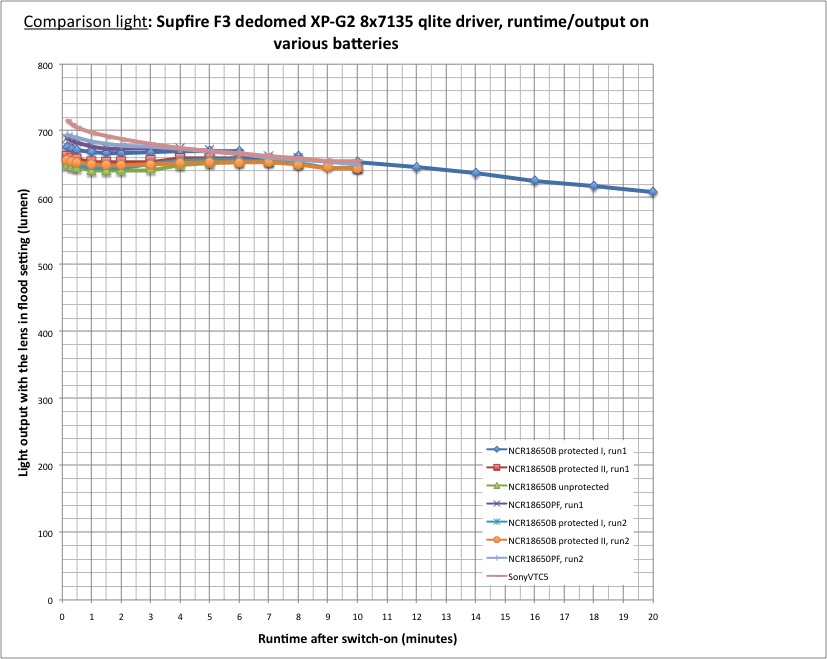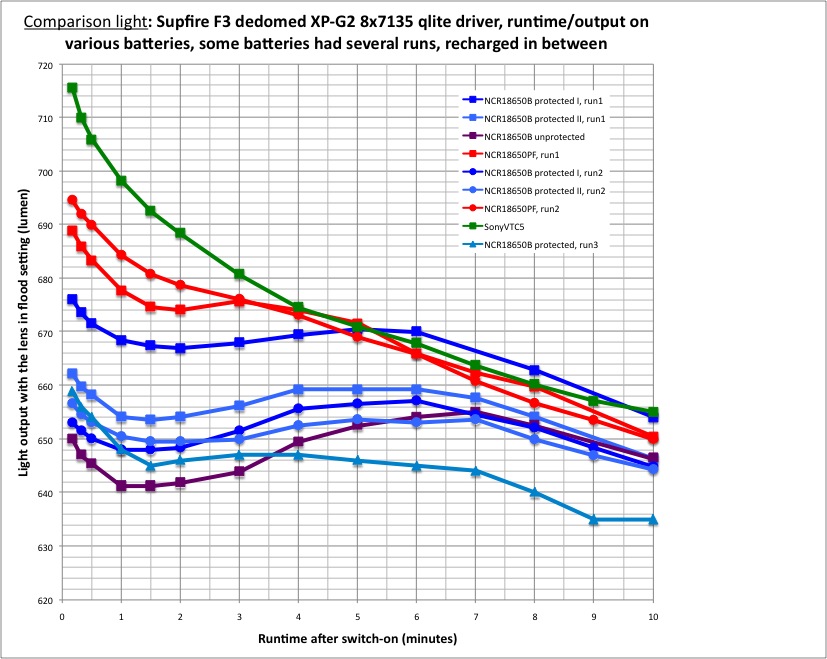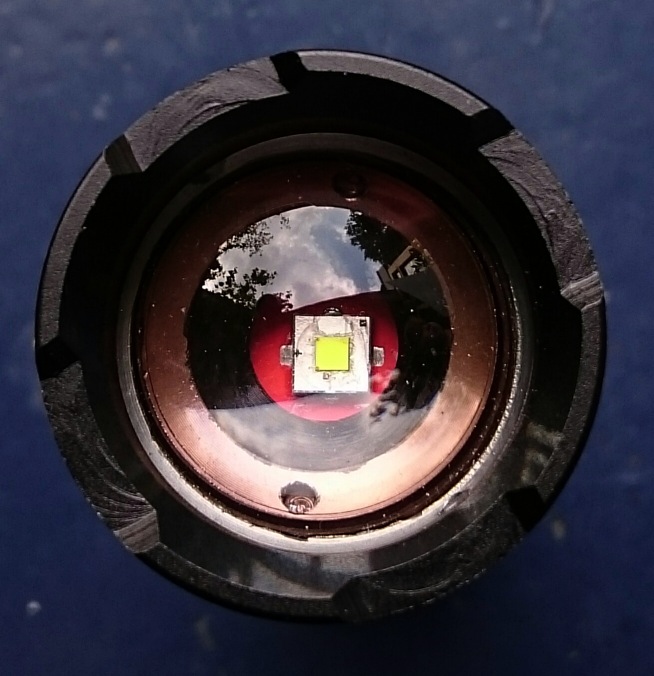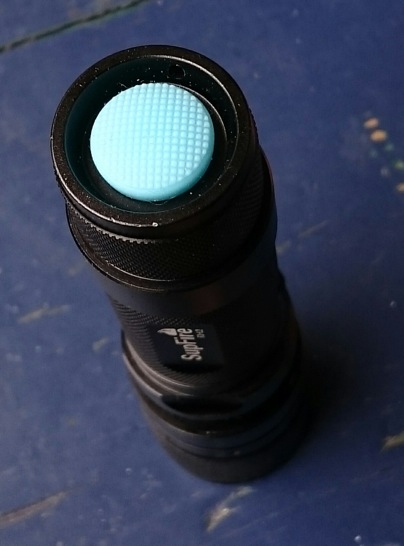
I had this plan to build a couple of constant output cheap zoomies (not this one), measure output in flood and throw position in my integrating sphere, and measure throw as well as I can. After that I would sell them at cost price to a few other BLF-members who do regular light measurements, so that we can compare our luxmeters and sphere/light-box calibrations (not to know who is wrong or right, it will not tell that, but to see how close we are). Light measurements will never be highly precise, but this should help a tiny bit to get it better.
These zoomies I would get as constant as possible by using a 2x7135 driver and a dedomed XP-E2 (output in flood under 200 lumens, throw 24kcd), very underdriven for BLF-standards, but very good for light output constantness because heat sag and battery sag (7135 output is a bit sensitive to input voltage, I found in practice) will hardly be an issue. The only possible issue with low output lights is that the output and throw will not be in the same range that most BLF-users use for their regular measurements. However, this is not a problem, I found, because all (=three) luxmeters that I have done some tests on, have no noticable lineairity problems (what I mean by good lineairity: a light source with exact 10 times as much output, will give a precise 10 times increased reading).
In a PM-session with Kloepper Knife Works (Henry), he asked to build such a light for him (and for others, he would make sure that the light makes a tour along interested folks), but despite my explanation that a low output light would suffice, he rather wanted a light with more output and throw. So this 8x7135(Qlite)driver dedomed XP-G2 S4 2B on Noctigon Supfire F3 mod is what I build for him to the best of my abilities (one thing I did is that I heatsinked all 7135 -chips of the Qlite driver that I used, the stock driver is used as a contact board). And as I predicted, when the light was finished it indeed has extra constantness problems that come with the higher output, including a possible slow output decay of the dedomed XP-G2 used :sick: (told you so! 
 ).
).

Output.
To compensate for the light not being really constant in output and so still be able to use it as a reference light source I had to characterise it: I tested runtime/light output with a number of battery types (all started fresh from the Opus BT-C3100 V2.2 charger), and did multiple sessions with the same battery (recharged in between of course) as well. Here are some results in a graph:

So it appears that the outputs on different batteries are in the same ballpark, and not decreasing much during the runtime , but there is a clear variation, if you read between 1 and 2 minutes about 7% between the lowest and highest curve. And that is too much, you really want to know if your flashlight throws 400kcd or that it is 430kcd, right?
Let's zoom in on the output scale and chop the graph at 10 minutes:

Lots of interesting things going on between the batteries but a nice constant light source independant of batteries or runtime this is not. Let's discuss a few things that I see.
*As I more or less expected for this high voltage emitter, the flashlight goes out of regulation after about 6 minutes. I'm glad that I swapped the switch for a big Omten, bypassed all springs and used thick wiring all through the flashlight.
*the first run I did was for a full 20 minutes without cooling (dark blue line with squares). The light got very very hot after 20 minutes. All subsequent runs were therefore stopped at 10 minutes. As you can see, even with the exact same battery, the output never got as high as that first run, in fact even when stopping after ten minutes instead of 20, in each run the output became a bit lower, also when a third run was done with one of the batteries (that one went a bit different than the others, I don't know why). I hope to come up with something different but for the moment my explanation for the lower output each time is slow detoriation of the emitter: 3A for only 10 minutes, even on a DTP copper board seems not good for your dedomed XP-G2 ! My advice for further use of this flashlight is to stick to a maximum run of three minutes and then letting the flashlight cool down fully before a next run is started.
*the Panasonic NCR18650B (I tested three, two protected versions and one unprotected) shows a sort of S-curve that is particularly flat between 1 and 2 minutes. The PF shows that 'S' in just one of the two runs, and the Sony does not show it at all. If we stick to that (widely owned) NCR18650B battery and measure between 1 and 2 minutes, we become more accurate than 7%, the variation between the highest and lowest curve is now 2% (I would accept that: every other error ignored, a throw measurement of 400kcd would in reality vary between 396 and 404).
*For comparison, the 2x7135dedomedXP-E2 14500zoomie that I built for my own use has a 4 times as low output and throw, but is accurate within 1% between 1 and 2 minutes, and more accurate after a ten minutes warm-up. It looses regulation after 45 minutes.
Throw. Any output variation, as measured above, is directly reflected in the throw variation of the flashlight. So the throw numbers that I measured vary a bit with battery, runtime and detoriation of the led. The throw measurements were done just before the last runtime/output test (run3 of the protected NCR18650B), so you can figure out that the 'detoriation state' of the led was just a bit better than that last run during the throw measuring. I hope that if others using this light for measurements keep to the three minutes per run, the led quality remains constant enough for the planned use of the flashlight.
I measured throw at a distance of exactly 5 meters from the front of the lens to the front of the (Mobilux A) luxmeter-detector (for a thread about this luxmeter vs a few others, see here). I used a fully charged battery, switched the light on, focussed the die as sharp as possible, and searched between one and two minutes for the maximum reading of the luxmeter, while moving the hotspot around over the detector. For every maximum reading to be valid I must have seen the number at least twice in the minute of measuring. For the record, in a typical dedomed-Cree-led-aspheric-flashlight-hotspot, the maximum reading can be found in the middle between the bond wires, close to the side where the bond wires attach to the die.
Here is the throw using some different batteries: protectedNCR18650B#1:81kcd, protectedNCR18650B#2:83kcd, unprotectedNCR18650B:80kcd, NCR18650PF:85kcd.
Output difference between flood and throw. This is an interesting ratio because it tells you something about the quality of the integration of your integrating sphere/lightbox. Ideally you would like to have a flashlight that has exactly the same output in flood and throw modus, and your light measuring contraption should then also measure exactly the same output if the integration is perfect. This flashlight does not exist, so as a poor alternative we can all measure the ratio between flood and throw of this same zoomie, if this ratio is fairly constant over the various contraptions, the light integration quality will also be comparable (and hopefully good enough).
For a certain battery set-up, measured after a minute and within 10 seconds, in my integrating sphere #2, this flashlight's output was 3.85 in flood, 12.26 in throw (numbers were not converted in lumens), so the throw/flood ratio in my sphere measures 0.314.
Conclusion: I have learned a few things from this light about flashlight and battery output behaviour (that was fun  ), but this flashlight would not be my ultimate light of choice for comparing light measuring devices of different flashoholics, it can be more precise than this, and I may send around some lower output but more precise zoomie flashlight at some point (but other projects are waiting first).
), but this flashlight would not be my ultimate light of choice for comparing light measuring devices of different flashoholics, it can be more precise than this, and I may send around some lower output but more precise zoomie flashlight at some point (but other projects are waiting first).
That said, this light has a fairly constant output, and because I characterised it fairly well, if some guidelines are followed (all users should use the same type of batteries, measure between 1 and 2 minutes, switch off to fully cool down after a maximum run of three minutes), it can be used to compare our calibrations, and at least reveal differences that are big, I dare say differences larger than 5% can be spotted.
So I will send this light to Henry tomorrow and hope he is happy with it. At some point I would like the flashlight back and redo the measurements to see if/how the numbers have altered during the trip. I hope that underway people will add their own measurements on this flashlight to this thread, so an idea can be formed of the various calibrations around.


 .
.